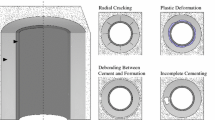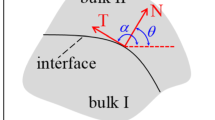Abstract
The solution for the elastic three-phase circular inclusion problem plays a fundamental role in many practical and theoretical applications. In particular, it offers the fundamental solution for the generalized self-consistent method in the mechanics of composites materials. In this paper, a general method is presented for evaluating the interaction between a pre-existing radial matrix crack and a three-phase circular inclusion. The bonding at the inclusion-interphase interface is considered to be imperfect with the assumption that the interface imperfections are constant. On the remaining boundary, that being the interphase-matrix interface, the bonding is considered to be perfect. Using complex variable techniques, we derive series representations for the corresponding stress functions inside the inclusion, in the interphase layer and the surrounding matrix. The governing boundary value problem is then formulated in such a way that these stress distributions simultaneously satisfy the traction free condition along the crack face, the imperfect interface conditions and the prescribed asymptotic loading conditions. Stress intensity factor (SIF) calculations are performed at the crack tips for different material property combinations, imperfect interface conditions and crack positions. The results illustrate convincingly the role of an interphase layer as well as the effects of an imperfect interface on crack behavior. For instance, when the interphase layer is softer than the inclusion and matrix, the results show that the radial matrix crack will propagate from the nearby crack tip regardless of the level of the imperfect (spring-layer) interface parameter. In comparison, when the interphase layer is stiffer than the inclusion and matrix, the interphase layer will shield the crack from effects of the imperfect (spring-layer) interface. Hence, these results provide a quantitative description of the interaction problem between a three-phase inclusion with interface imperfections and a radial matrix crack.
Similar content being viewed by others
References
J.D. Achenbach H. Zhu (1989) ArticleTitleEffect of interfacial zone on the mechanical behavior and failure of fiber reinforced composites Journal of the Mechanics and Physics of Solids 37 381–393 Occurrence Handle1989JMPSo..37..381A
J.D. Achenbach H. Zhu (1991) ArticleTitleEffect of interphase on micro and macromechanical behavior of hexagonal arary fiber composites ASME Journal of Applied Mechancis 58 444–449
J. Aboudi (1987) ArticleTitleDamage in composites-modeling of imperfect bonding Composites Science and Technology 28 103–128
W. Amenyah C.Q. Ru P. Schiavone A. Mioduchowski (2001) ArticleTitleInterior cracking of a circular inclusion with imperfect interface under thermal loading Mathematics and Mechanics of Solids 6 525–540 Occurrence Handle01851088
C. Atkinson (1972) ArticleTitleThe interaction between a crack and an inclusion International Journal of Engineering Science 10 127–136 Occurrence Handle0224.73098
Y. Benveniste (1984) ArticleTitleOn the effect of debonding on the overall behavior of composite materials Mechanics of Materials 3 349–358
Y. Benveniste G.J. Dvorak T. Chen (1989) ArticleTitleStress fields in composites with coated inclusions Mechanics of Materials 7 305–317
D. Bigoni S.K. Serkov M. Valentini A.B. Movchan (1998) ArticleTitleAsymptotic models of dilute composites with imperfectly bonded inclusions International Journal of Solids and Structures 35 3239–3258 Occurrence Handle0918.73042 Occurrence Handle1628211
A. Chandra Y. Huang K.X. Hu (1997) ArticleTitleCrack-size dependence of overall responses of fiber reinforced composites with matrix cracking International Journal of Solids and Structures 34 3837–3857 Occurrence Handle0942.74630
B.A. Cheeseman M.H. Santare (2001) ArticleTitleThe effect of the interphase on crack-inclusion interactions International Journal of Fracture 109 303–323
R.M. Christensen K.H. Lo (1979) ArticleTitleSolutions for effective shear properties in three phase sphere and cylinder models Journal of Mechanics and Physics of Solids 27 315–330 Occurrence Handle0419.73007 Occurrence Handle1979JMPSo..27..315C
R.M. Christensen (1990) ArticleTitleA critical evaluation for a class of micromechanics model Journal of Mechanics and Physics of Solids 38 379–404 Occurrence Handle1990JMPSo..38..379C
J. Dundurs T. Mura (1964) ArticleTitleInteraction between an edge dislocation and a circular inclusion Journal of Mechanical Physics and Solids 12 177–189 Occurrence Handle175390 Occurrence Handle1964JMPSo..12..177D
Erdogan, F., Gupta, G.D. and Ratwani, M. (1974). Interaction between a circular inclusion and an arbitrarily oriented crack.ASME Journal of Applied Mechanics 1007--1013.
Z. Hashin (1990) ArticleTitleThermoelastic properties of fiber composites with imperfect interface Mechanics of Material 8 333–348
Z. Hashin (1991) ArticleTitleThe spherical inclusion with imperfect interface ASME Journal of Applied Mechanics 58 444–449 Occurrence Handle10.1115/1.2897205
Y. Huang K. Hu A. Chandra (1994) ArticleTitleA generalized self-consistent mechanics method for microcracked solids Journal of the Mechanics and Physics of Solids 42 1273–1291 Occurrence Handle0807.73038 Occurrence Handle1994JMPSo..42.1273H
Y. Huang A. Chandra Z.Q. Jiang (1996) ArticleTitleThe numerical calculation of two dimensional effective moduli for microcracked solids International Journal of Solids and Structures 33 1575–1586 Occurrence Handle0900.73669
Y Liu C.Q. Ru P. Schiavone A. Mioduchowski (2001) ArticleTitleNew phenomena concerning the effect of imperfect bonding on radial matrix cracking in fiber composites International Journal of Engineering Science 39 2033–2050
T.C. Lu J. Yang Z. Suo A.G. Evans R. Hecht R. Mehrabian (1991) ArticleTitleMatrix cracking in intermetallic composites caused by thermal expansion mismatch Acta Metall. Mater 39 1883–1890
H.A. Luo Luo G.J. Weng (1989) ArticleTitleOn Eshelby’s s-tensor in a three-phase cylindrically concentric solid, and the elastic moduli of fiber-reinforced composites Mechanics of Materials 8 77–88
H.A. Luo Y. Chen (1991) ArticleTitleAn edge dislocation in a three-phase composite cylinder model ASME Journal of Applied Mechanics 58 75–86 Occurrence Handle10.1115/1.2897182 Occurrence Handle0756.73059
W.H. Müller S. Schmauder (1993) ArticleTitleOn the behavior of r- and θ-cracks in composite materials under thermal and mechanical loading International Journal of Solids and Structures 59 307–343
N.I. Muskhelishvili (Eds) (1963) Some Basic Problems of the Mathematical Theory of Elasticity P. Noordhoff Ltd. Netherlands Occurrence Handle0124.17404
L. Stagni (1999) ArticleTitleThe effect of the interface on the interaction of an interior edge dislocation with an elliptical inhomogeneity Zeitschrift fur Angewcenate Mathematik und Physik 50 327–337 Occurrence Handle0927.74009 Occurrence Handle1687049 Occurrence Handle1999ZaMP...50..327S
L.J. Sudak C.Q. Ru P. Schiavone A. Mioduchowski (1999) ArticleTitleA circular inclusion with inhomogeneously imperfect interface in plane elasticity Journal of Elasticity 55 19–41 Occurrence Handle0974.74011 Occurrence Handle1742874
L.J. Sudak A. Mioduchowski (2002) ArticleTitleA three-phase circular inhomogeneity with imperfect interface under thermomechanical loadings in plane elasticity Acta Mechanica 158 43–56 Occurrence Handle1156.74310
L.J. Sudak (2003) ArticleTitleInteraction between a screw dislocation and a three-phase circular inhomogeneity with imperfect interface Mathematics and Mechanics of Solids 8 171–188 Occurrence Handle1048.74008
O. Tamate (1968) ArticleTitleThe effect of a circular inclusion on the stresses around a line crack in a sheet under tension The International Journal of Fracture Mechanics 4 257–265
X. Wang Y.P. Shen (2002) ArticleTitleAn edge dislocation in a three-phase composite cylinder model with a sliding interface ASME Journal of Applied Mechanics 69 527–538 Occurrence Handle1110.74745
Z.M. Xiao B.J. Chen (2000) ArticleTitleA screw dislocation interacting with a coated fiber Mechanics of Materials 32 485–494
Z.M. Xiao B.J. Chen (2001) ArticleTitleOn the interaction between an edge dislocation and a coated inclusion International Journal of Solids and Structures 38 2533–2548 Occurrence Handle1052.74516
Z.M. Xiao B.J. Chen (2001) ArticleTitleStress intensity factor for a Griffith crack interacting with a coated inclusion International Journal of Fracture 108 193–205
Author information
Authors and Affiliations
Corresponding author
Rights and permissions
About this article
Cite this article
Kim, K., Sudak, L.J. Interaction between a radial matrix crack and a three-phase circular inclusion with imperfect interface in plane elasticity. Int J Fract 131, 155–172 (2005). https://doi.org/10.1007/s10704-004-3636-6
Received:
Accepted:
Issue Date:
DOI: https://doi.org/10.1007/s10704-004-3636-6




